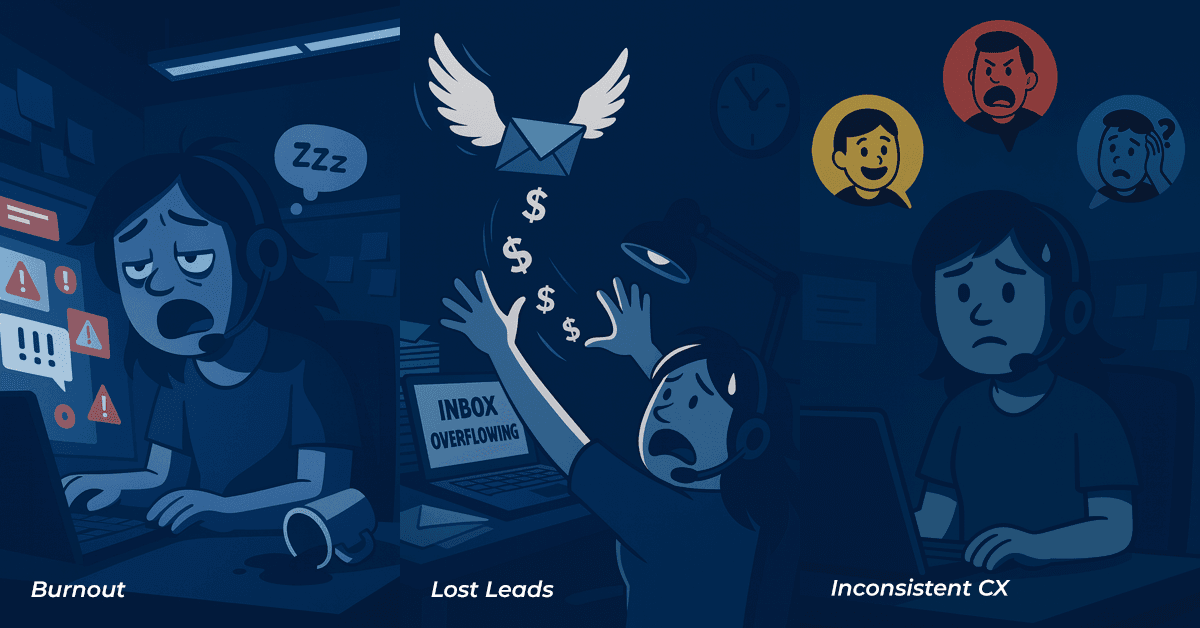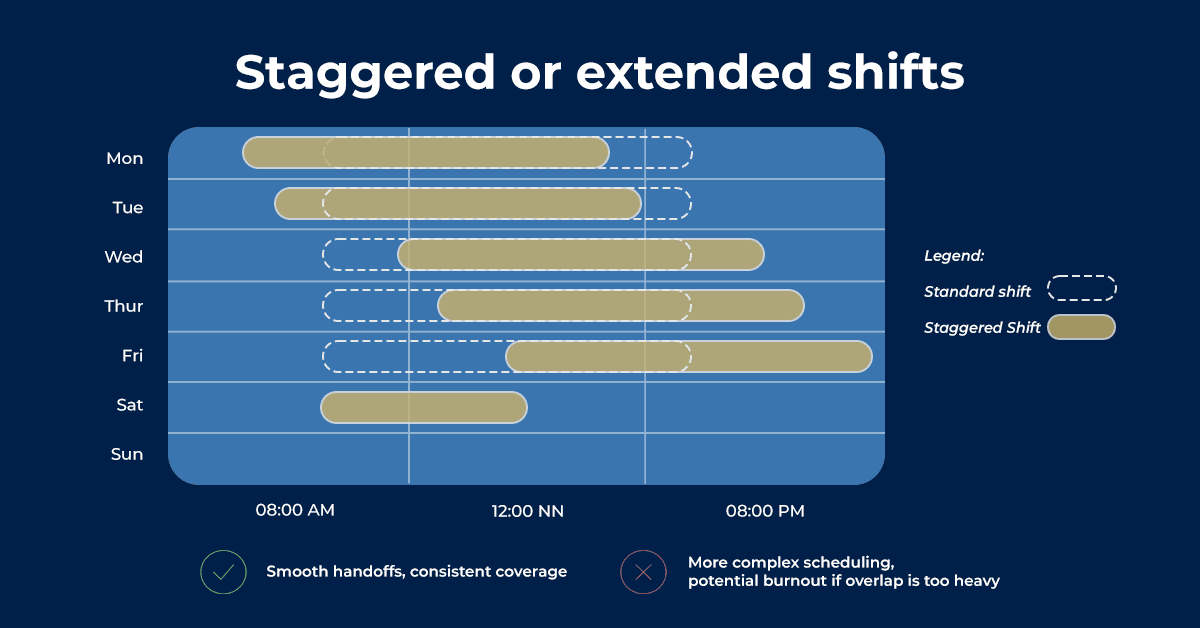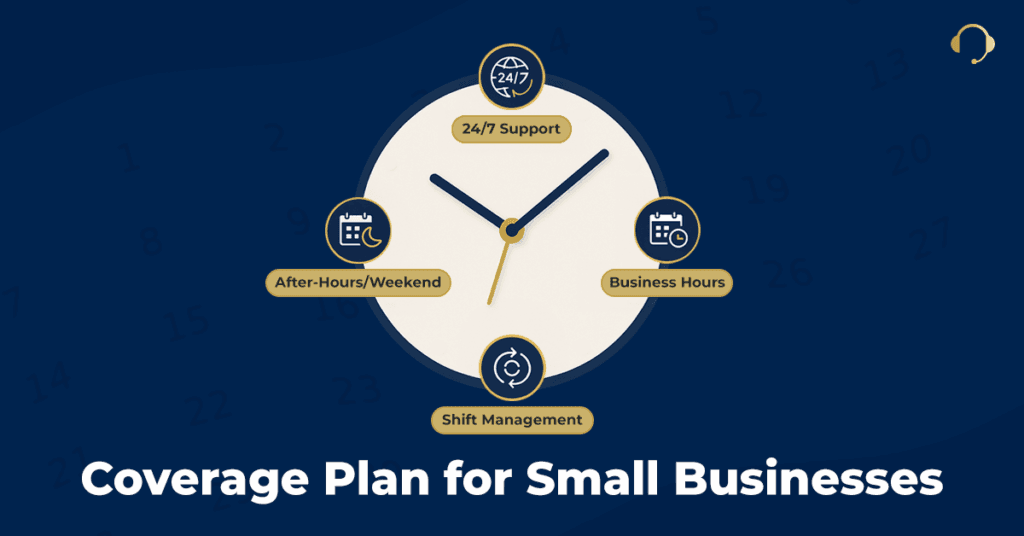Let’s face it, running support at a small business often feels like juggling swords… while on fire. You’re trying to grow, serve customers, and stay sane — all at once. Without a smart coverage plan, your team gets burned out, customers fall through the cracks, and your brand takes the hit.
This guide is your no-fluff, slightly snarky blueprint for building a support coverage plan that works for you, your team, and your growing customer base.
Why Bother with a Coverage Plan?

Because “winging it” is not a long-term strategy. Without a plan, small businesses face:
-
Burnout: Your one support rep (or, let’s be honest, you) is always on-call. That’s not sustainable.
-
Lost leads: If a hot lead emails at 9 PM and hears back two days later? Goodbye, revenue.
-
Inconsistent CX: Customers want support when they need it — not when you happen to check Slack.
The good news? A solid plan prevents all this. It gives structure, sanity, and scale.
Business Hours: Align with Your Customers (and Set Expectations)
Not every business needs 24/7 support, but you do need coverage that aligns with when customers reach out. Dig into your inquiry data — are people pinging you at 8 AM or 10 PM?
Equally important is setting clear expectations with customers about your availability. Publish your support hours prominently on your website, contact page, and auto-responders. There’s nothing worse for a customer than firing off a help request and hearing nothing because they didn’t realize you’re closed. If you aren’t truly 24/7, be upfront about when you are available and how quickly you respond during off-hours. Customers appreciate honesty almost as much as they appreciate speedy answers.
Of course, extending business hours isn’t as simple as flipping a sign, it requires staff (more on that next). But even if you can’t afford to cover all the hours you’d like, a coverage plan helps you maximize the hours you can cover effectively. Focus on the highest-impact times. You might choose to start support an hour earlier or later based on demand, or add weekend mornings if that’s when questions spike. The goal is to be available when your customers most often need you, instead of rigidly sticking to legacy hours that leave valuable contacts waiting.
Shift Management: No More Zombie Agents on Duty
Once you’ve defined your ideal support hours, the next challenge is staffing those hours without driving your team to zombie status. Welcome to the art of shift management, or, essentially, how you schedule your support agents (even if that “agent” is just you and one colleague right now).
The key principle is to rotate and balance shifts so that no one gets stuck with all the undesirable hours. If you extend coverage into evenings or weekends, don’t make it permanent punishment for one poor soul. Rotate the responsibility if you have a team, so everyone takes turns handling an evening or Saturday shift, for example. This prevents burnout and resentment, nobody likes feeling like the only one without a life because they’re always on the late shift. When rotation isn’t possible (say you only have one support rep besides yourself), consider hiring part-time or contracting help for specific shifts.
Lastly, be human and build your shifts to accommodate real life. Parents might prefer early shifts, night owls might thrive on late ones. Flexibility can boost morale. Your support agents are your front-line warriors; a fair and thoughtful shift plan keeps them engaged instead of enraged. Happy team = happier service for customers.
After-Hours and Weekend Coverage: Issues Don’t Sleep (Even If You Do)
Ah, the eternal small business dilemma: Do we offer support after 5 PM and on weekends? On one hand, you want to enjoy your evenings and your team’s sanity. On the other, you hate the idea of a customer’s urgent plea sitting unattended till Monday or a juicy sales inquiry going cold by morning. After-hours and weekend coverage is a must-have element in a modern support plan, especially as your customer base grows beyond the confines of a single time zone or schedule.
Let’s face it: customer issues and questions can pop up at the most inconvenient times (Murphy’s Law of Customer Service). It’s no surprise that companies providing 24/7 or after-hours support report higher customer satisfaction. People feel cared for when someone’s there for them at 11 PM in an emergency. In fact, after implementing extended weekend support, one Ethos client, SwingLogic, saw a 32% improvement in first-response time to customers. That quicker help meant happier golfers (literally!) and even fewer product returns for SwingLogic. It’s amazing what a little Saturday support shift can do.
So how can a small business manage after-hours coverage without cloning yourself? You’ve got a few options:
-
Rotating on-call duty: If you have a small team, you might rotate an on-call schedule for emergencies. For example, each team member takes one night a week where they’ll keep an eye on the support inbox or phone for truly urgent issues. Just be sure to define what “urgent” means. And compensate your team with an on-call bonus or extra time off… pizza parties only go so far in repaying lost sleep!

-
Staggered or extended shifts: As mentioned earlier, you can stagger shifts later into the evening. Maybe instead of everyone clocking out at 6, one person works 11 AM–7 PM a couple days, another covers 12–8 PM on others. This way your “open” hours extend naturally. For weekends, consider half-days if full days aren’t feasible, e.g., a Saturday morning support session to catch anything that came in Friday night and handle Saturday inquiries in real-time.

-
Outsourcing after-hours support: If maintaining your own night watch isn’t practical, you can partner with an external service to handle customer queries after your team signs off. The BPO (Business Process Outsourcing) route can be surprisingly flexible. For instance, Ethos Support offers on-demand teams with 24/7/365 coverage ready to step in exactly when you need them. You could have a trained agent (who knows your business) handling chats at midnight so you don’t have to. This ensures no customer is left hanging, and you only pay for coverage you actually use. No more groggy Sunday mornings frantically answering support tickets with one bleary eye open.

Whichever approach (or combo) you choose, make sure after-hours coverage is intentional. Even if you decide “we’ll only offer email support on weekends but no live calls,” that’s fine, just have a plan and communicate it. Maybe you set up an auto-reply at night: “We’re recharging our batteries and will respond first thing in the morning.” That’s a lot better than customers feeling ignored. A coverage plan might also include a knowledge base or chatbot to handle FAQs after hours. Many customers are happy to self-serve at 2 AM if you give them good help articles or an AI chatbot to engage with. This can deflect some off-hour workload and keep folks satisfied until a human is available.
Channel Strategy: Choose Your Levers Wisely
In the quest to support customers effectively, how you talk to them is just as important as when. That’s where your channel strategy comes in. These days, customers might contact you via phone, email, live chat, social media, or even text. As a small business, it’s tempting to try to be everywhere: “Omnichannel or bust!”, right? But each channel you add is like another spinning plate you have to keep from crashing. A smart coverage plan includes deciding which support channels to offer (and when) so that you can deliver a great experience on each, rather than stretching yourself too thin on all.
Here are some channel considerations as you develop your plan:
-
Phone Support: It’s as classic as it gets. Many customers still love the reassurance of a human voice and the immediacy of a phone call. But phone is also the most demanding channel where customers expect quick pick-up and real-time resolution. If you offer phone support, ensure you have the coverage to answer calls promptly during your stated hours (long hold times will tank satisfaction).
-
Live Chat & Messaging: Online chat is hugely popular for providing instant help while customers browse your site. It’s convenient for them and can be efficient for your team where one agent can juggle multiple chats at once (to a point). The catch: once a customer starts a live chat, they expect immediate back-and-forth. If your coverage is spotty, an unattended chat is like inviting someone to a conversation and then ghosting them. Not a good look. So only have live chat activated when you have agents available to manage it. The great part is you can often configure chat availability to match your staffed hours.
-
Email Support: The trusty old workhorse of customer support. Email is inherently more async where customers know it might take a few hours or a day to get a reply (though they secretly hope for sooner!). This channel is generally less resource-intensive to cover, because agents can queue emails and tackle them in order. However, don’t neglect speed here either. The average response time for customer service emails is still around 12 hours, which is not impressive in an era of instant gratification. Beat that benchmark and you’ll stand out. With email, coverage planning means setting a target SLA (say, respond to all emails within 4 hours during business hours, or by the next morning if received at night) and making sure staffing and processes meet it.
-
Social Media: Many customers treat X, Facebook, TikTok or Instagram as support channels by tagging your business or dropping questions in DMs. If you have a social media presence, you’ll need to cover these too (or politely redirect them to official support). Response expectations on social can be high; it’s public, after all. A lot of brands use social primarily for monitoring and damage control for complaints. Depending on your size, you might fold social responses into your support team’s duties. Just ensure someone is assigned to peek at socials daily if you promise support there. And if you can’t manage one more channel, it’s okay to not heavily advertise social as a support option. It’s better to have none than to have an unmanned one.
-
Self-Service: Not a channel per se, but worth mentioning again: a knowledge base or FAQ site can be your 24/7 “agent” that never sleeps. Many small businesses underestimate how much a good FAQ or tutorial can deflect routine questions. A solid self-service offering means customers get answers immediately without contacting you at all, freeing up your team’s coverage for the complex issues that truly need attention.
Scaling with Demand: Ready, Set, Grow!
One of the best problems for a small business to have is growing demand: more customers, more orders… and yes, more support tickets. But growth can quickly turn into a nightmare if your support coverage doesn’t scale with it. An overwhelmed support team leads to backlogged emails, dropped calls, frazzled nerves, and unhappy customers (the exact opposite of what you want, especially when business is booming). That’s why an often-overlooked element of a coverage plan is planning for scalability.
Here’s how to future-proof your support coverage as you scale:
-
Build elasticity into your team. If you’re hiring in-house, consider part-time or flex-time support agents who can increase hours when things get busy (and maybe reduce during lulls). University students or seasonal workers can be great here. You could, for instance, have a pool of trained “on-call” helpers for holiday season or new product launches. Cross-training employees from other departments to handle simple support queries in peak times is another way to flex up capacity without permanent headcount. The key is to avoid the trap of running things at 110% capacity all the time; have a buffer or surge plan so peak demand doesn’t break your system.
-
Leverage outsourcing for burst support. We’ve touched on using external partners for off-hours, but they are also fantastic for load balancing during high demand. The right outsourcing partner can quickly add agents to your team when you need them, and scale back when things quiet down, all while maintaining quality. Ethos Support, for example, operates on a model with no minimum agent requirements and no long-term contracts, meaning you can scale your support team up or down on the fly to match your needs. Launching a big promo and expect ticket volume to double for a month? No problem, spin up an extra agent or two via Ethos for that period. This kind of flexibility keeps your core team from drowning in work and ensures customers still get prompt service no matter how your business fluctuates.
-
Invest in processes and training now. The processes you establish when your team is small will either support or hinder you when you’re larger. Document your support procedures (how to answer common questions, escalation paths for complex issues, etc.) so that bringing on new agents, whether in-house or outsourced, is faster and smoother. A well-defined onboarding and training plan means you can add support staff in weeks instead of months without chaos. SwingLogic’s story is a great example: when they expanded their product line and expected a support surge, they partnered with Ethos to assemble a skilled team within 2 weeks using Ethos’s streamlined 8-step hiring and training process. They were able to handle growth without missing a beat in service quality.
-
Use technology to multiply output. As demand grows, tech tools are your friend. A good ticketing system or CRM ensures nothing falls through the cracks even as volume increases. Automations (like tagging, routing, and canned responses for FAQs) can make a small team feel bigger. Analytics will pinpoint new hotspots (maybe that new feature you launched is confusing users at first, time for a help article or a dedicated support blitz). Scaling isn’t just about people; it’s about working smarter. The right tools can help a few agents handle the work of many; up to a point, of course. Don’t try to only throw tools at the problem; combine them with the human strategies above.
The goal of scaling your coverage is maintaining the same (or better) level of support as you grow, without your team burning out or your costs exploding. Remember, a smart coverage plan isn’t static. It grows with you. By thinking ahead, you’ll avoid the common growing pains of scaling businesses. Namely, the dreaded scenario where sales outpaces support and customers churn because service can’t keep up. Not on your watch!
The Payoff: Happy Customers, an Energized Team, and Growth

We’ve covered a lot of ground (high five if you’re still with us). But all these moving parts, hours, shifts, channels, and scaling ultimately serve a simple purpose: to deliver consistently great customer support without driving your team into the ground. When you execute on a solid coverage plan, here’s what you can look forward to:
-
Happier Customers: This is the big one. With better coverage, customers get timely, helpful answers whenever they reach out, be it Monday 9 AM or Saturday 9 PM. Quick, consistent support means higher customer satisfaction and loyalty. You’ll likely see your CSAT scores improve and those once-angry tweets turn into positive reviews. Customers who feel taken care of stick around longer and even spend more. (Hey, 94% of customers say they’re likely to purchase again from a company with very good customer experience, and you will be that company with your new coverage plan in action.)
-
No More Support Burnout: Your team will thank you, probably with actual smiles and not just coffee-fueled grimaces. By balancing shifts, giving folks time to rest, and eliminating the panic of constant “after-hours” emergencies, you create a healthier work environment. Lower burnout means lower turnover, which means you keep experienced staff around. They’ll have the energy to go the extra mile for customers instead of secretly updating their resumes. A well-rested support team is a friendly, effective support team, and that shines through in every customer interaction.
-
A Reputation for Reliability: Small businesses often win by building personal relationships and trust with customers. When people know they can count on your support, as opposed to leaving them high and dry, it becomes a competitive advantage. “They always take care of me, even if it’s late” is the kind of word-of-mouth marketing you can’t buy. By covering your bases, you’re essentially saying to customers, “We’ve got you, anytime.” That confidence in your service can set you apart from larger competitors who might treat small customers like numbers.
-
Prepared for the Big Leagues: Finally, a robust coverage plan prepares your company for growth. When you have the infrastructure (people, processes, partners) to handle more customers, you won’t fear success, you’ll embrace it. Scaling up support alongside sales will feel natural instead of chaotic. You’ve thought about 24/7 support, multiple channels, peak times… so landing that new account on another continent or dealing with a holiday shopping frenzy won’t break your system. In other words, you’ve future-proofed your customer experience. And as a bonus, investors or partners love to see that a company has its support act together– it signals you’re running a tight ship ready for expansion.
To sum it up, a smart support coverage plan is worth every bit of effort. It’s like the unsung hero of business growth, quietly ensuring customers stay happy and engaged, which in turn drives revenue and referrals, all while keeping your team motivated and sane. Now that’s a win-win-win.
Conclusion: Cover Your Bases and Reap the Rewards
Building a comprehensive support coverage plan might sound like a lot of work, but here’s the good news: you don’t have to do it alone (and it can even be fun; yes, fun!). With the right approach and the right partner, even the smallest business can deliver big-time support.
Ethos Support exists exactly for this reason. To help businesses like yours create support that scales with you. Whether you need customer service agents answering chats at midnight or a technical support solution for your complex product questions, we’ve got your back. Our flexible model means you can get one on-brand rockstar agent or a whole team, 24/7 or just weekday coverage, tailored to your needs. No long-term strings attached… just world-class support on your terms.
In the end, a great support coverage plan lets you sleep easier (literally). Your customers get help when they need it, your team isn’t running on fumes, and you can focus on growing the business rather than firefighting. That’s the power of being prepared. So go forth and cover your bases!



